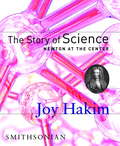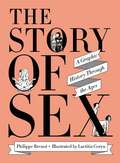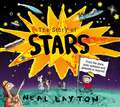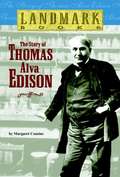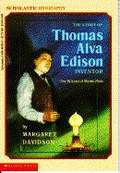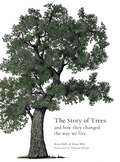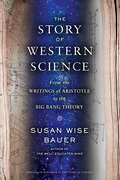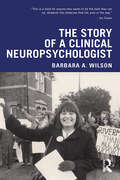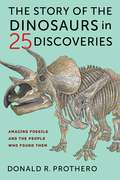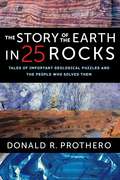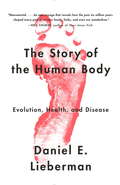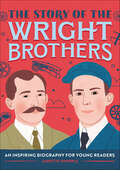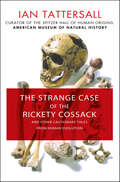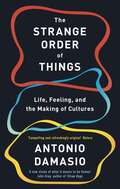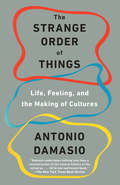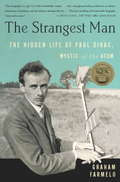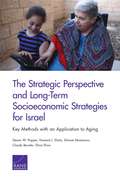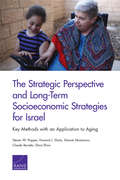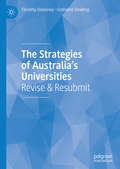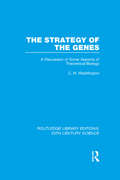- Table View
- List View
The Story of Science: Newton at the Center
by Joy HakimIn volume two, students will watch as Copernicus's systematic observations place the sun at the center of our universe--to the dismay of establishment thinkers. After students follow the achievements and frustrations of Galileo, Kepler, and Descartes, they will appreciate the amazing Isaac Newton, whose discoveries about gravity, motion, colors, calculus, and Earth's place in the universe set the stage for modern physics, astronomy, mathematics, and chemistry.In the three-book The Story of Science series, master storyteller Joy Hakim narrates the evolution of scientific thought from ancient times to the present. With lively, character-driven narrative, Hakim spotlights the achievements of some of the world's greatest scientists and encourages a similiar spirit of inquiry in readers. The books include hundreds of color photographs, charts, maps, and diagrams; informative sidebars; suggestions for further reading; and excerpts from the writings of great scientists.
The Story of Sex: A Graphic History Through the Ages
by Philippe Brenot Laetitia Coryn Will McmorranThe first graphic history of sex chronicles sexuality and human intimacy through the ages, from our primate pasts to our robotic futures.Humans have had sex on the brain since pre-civilization either for pleasure, power, revenge, a desire for children, or simply because it isn't allowed. Today, sex is all around us but it's rarely explained and almost never taught. In The Story of Sex, sexologist Phillipe Brenot combines anthropology, sociology, psychology and history with witty comics by Latetita Coryn for an in-depth explanation of this essential aspect of humanity. Organized chronologically into sections like Babylon: Free Love, The Middle Ages: Heaven and Hell, and The 20th Century: Sexual Liberation, Brenot explores what eroticism really is, how our ancestors behaved sexually, when the first couple was established, how superstition and morality laws shaped sexuality, the use of pornography in the digital age, and how some ancient civilizations were far ahead of their time when it came to gender equality.Full of fascinating details like Cleopatra's invention of the vibrator and a Dutch shopkeeper's accidental discovery of the existence of sperm--all accompanied by hilarious comics and dialogue--The Story of Sex is informative, unique, and entertaining book.
The Story of Stars
by Neal LaytonEach night as the sun goes down and the sky grows dark, STARS come out. But what are stars? Where are they? And what role have they played throughout history?Over thousands of years humans have gazed up curiously at the stars, wondering why the sky looks the way it does. Step back in time and see how these theories have changed over the years, and what we now know about these sparkling celestial objects. From the stars, to solar systems to galaxies and beyond, this bold and funny book from Neal Layton tells you everything you've ever wanted to know about the night sky.
The Story of Thomas Alva Edison
by Margaret CousinsA biography of the great inventor whose creations have contributed to the comfort, convenience, and entertainment of people all over the world.
The Story of Thomas Alva Edison, Inventor: The Wizard of Menlo Park
by Margaret DavidsonAn accessible biography that explains the basic scientific principles behind Edison's discoveries as well as his joys, tragedies, and amazing successes.
The Story of Trees
by Kevin;West David“Wonderful stories and in-depth information you will normally never find in books about trees.†Piet Oudolf, Landscape Designer and creator of the planting design for New York’s High Line“Entwining fascinating facts about 100 trees with inspiring stories of their importance to ancient civilizations, trade, religious and pagan beliefs, wellbeing and medicinal uses over the ages, this delightful and well-researched book provokes curiosity on every page.†Dr. Alexandra Wagstaffe, Eden Project LearningThe Story of Trees takes the reader on a visual journey from some of the earliest known tree species on our planet to the latest fruit cultivars.The chosen trees have all had a profound effect on the planet and humankind. Starting with the Ginkgo biloba, fossils of which date back 270 million years, we learn about how trees came to be integral to the development of our species, and how specific trees have become important religious, political, and cultural symbols.With beautiful illustrations by Thibaud Herem and fascinating botanical facts and figures, this book will appeal to tree lovers from all over the world. “Within these pages, we hope to inform and inspire those who already have a love of trees, as well as those who otherwise may have taken them for granted. The Story of Treesis our story, but also that of our ancestors. It is about our relationship with some of the world’s most important trees, both on a local scale and globally. With so many trees to choose from, we have endeavored to feature those that have been, and in most cases continue to be, of cultural and practical value to humankind.†-From the Introduction of The Story of Trees
The Story of Trees: And How They Changed the Way We Live
by David West Kevin Hobbs“Wonderful stories and in-depth information you will normally never find in books about trees.”Piet Oudolf, Landscape Designer and creator of the planting design for New York’s High Line“Entwining fascinating facts about 100 trees with inspiring stories of their importance to ancient civilizations, trade, religious and pagan beliefs, wellbeing and medicinal uses over the ages, this delightful and well-researched book provokes curiosity on every page.”Dr. Alexandra Wagstaffe, Eden Project LearningThe Story of Trees takes the reader on a visual journey from some of the earliest known tree species on our planet to the latest fruit cultivars.The chosen trees have all had a profound effect on the planet and humankind. Starting with the Ginkgo biloba, fossils of which date back 270 million years, we learn about how trees came to be integral to the development of our species, and how specific trees have become important religious, political, and cultural symbols.With beautiful illustrations by Thibaud Herem and fascinating botanical facts and figures, this book will appeal to tree lovers from all over the world. “Within these pages, we hope to inform and inspire those who already have a love of trees, as well as those who otherwise may have taken them for granted. The Story of Treesis our story, but also that of our ancestors. It is about our relationship with some of the world’s most important trees, both on a local scale and globally. With so many trees to choose from, we have endeavored to feature those that have been, and in most cases continue to be, of cultural and practical value to humankind.”-From the Introduction of The Story of Trees
The Story of Water: A Moving Adventure (Into Reading, Level P #57)
by Diane BairNIMAC-sourced textbook <p><p> There is a lot to learn about water! This book tells you all about it, including how important it is for life on Earth. You'll learn about water contamination and how we can all help save this precious resource.
The Story of Western Science: From the Writings of Aristotle to the Big Bang Theory
by Susan Wise BauerA riveting road map to the development of modern scientific thought. In the tradition of her perennial bestseller The Well-Educated Mind, Susan Wise Bauer delivers an accessible, entertaining, and illuminating springboard into the scientific education you never had. Far too often, public discussion of science is carried out by journalists, voters, and politicians who have received their science secondhand. The Story of Western Science shows us the joy and importance of reading groundbreaking science writing for ourselves and guides us back to the masterpieces that have changed the way we think about our world, our cosmos, and ourselves. Able to be referenced individually, or read together as the narrative of Western scientific development, the book's twenty-eight succinct chapters lead readers from the first science texts by Hippocrates, Plato, and Aristotle through twentieth-century classics in biology, physics, and cosmology. The Story of Western Science illuminates everything from mankind's earliest inquiries to the butterfly effect, from the birth of the scientific method to the rise of earth science and the flowering of modern biology. Each chapter recommends one or more classic books and provides entertaining accounts of crucial contributions to science, vivid sketches of the scientist-writers, and clear explanations of the mechanics underlying each concept. The Story of Western Science reveals science to be a dramatic undertaking practiced by some of history's most memorable characters. It reminds us that scientific inquiry is a human pursuit--an essential, often deeply personal, sometimes flawed, frequently brilliant way of understanding the world. The Story of Western Science is an "entertaining and unique synthesis" (Times Higher Education), a "fluidly written" narrative that "celebrates the inexorable force of human curiosity" (Wall Street Journal), and a "bright, informative resource for readers seeking to understand science through the eyes of the men and women who shaped its history" (Kirkus). Previously published as The Story of Science.
The Story of a Clinical Neuropsychologist
by Barbara A. WilsonFrom a disadvantaged childhood to becoming one of our best-loved clinical neuropsychologists, this exceptional book tells the life story of Barbara A. Wilson, who has changed the way we think about brain injury rehabilitation. Barbara’s story shows how it is possible to have a fulfilling career alongside a successful family life, even when faced with the deepest of personal tragedies; the death of her adult daughter Sarah. Clinical and neuropsychologists will recognise Barbara’s influence on rehabilitation practice and her tireless aim to get what is best for people needing neuropsychological rehabilitation. It will inspire those with brain injury and their families who may struggle to make life meaningful, as well as encourage readers to stick to their beliefs and triumph in the face of obstacles.
The Story of the Dinosaurs in 25 Discoveries: Amazing Fossils and the People Who Found Them
by Donald R. ProtheroToday, any kid can rattle off the names of dozens of dinosaurs. But it took centuries of scientific effort—and a lot of luck—to discover and establish the diversity of dinosaur species we now know. How did we learn that Triceratops had three horns? Why don’t many paleontologists consider Brontosaurus a valid species? What convinced scientists that modern birds are relatives of ancient Velociraptor?In The Story of the Dinosaurs in 25 Discoveries, Donald R. Prothero tells the fascinating stories behind the most important fossil finds and the intrepid researchers who unearthed them. In twenty-five vivid vignettes, he weaves together dramatic tales of dinosaur discoveries with what modern science now knows about the species to which they belong. Prothero takes us from eighteenth-century sightings of colossal bones taken for biblical giants through recent discoveries of enormous predators even larger than Tyrannosaurus. He recounts the escapades of the larger-than-life personalities who made modern paleontology, including scientific rivalries like the nineteenth-century “Bone Wars.” Prothero also details how to draw the boundaries between species and explores debates such as whether dinosaurs had feathers, explaining the findings that settled them or keep them going. Throughout, he offers a clear and rigorous look at what paleontologists consider sound interpretation of evidence. An essential read for any dinosaur lover, this book teaches us to see an ancient world ruled by giant majestic creatures anew.
The Story of the Earth in 25 Rocks: Tales of Important Geological Puzzles and the People Who Solved Them
by Donald R. ProtheroEvery rock is a tangible trace of the earth’s past. The Story of the Earth in 25 Rocks tells the fascinating stories behind the discoveries that shook the foundations of geology. In twenty-five chapters—each about a particular rock, outcrop, or geologic phenomenon—Donald R. Prothero recounts the scientific detective work that shaped our understanding of geology, from the unearthing of exemplary specimens to tectonic shifts in how we view the inner workings of our planet. Prothero follows in the footsteps of the scientists who asked—and answered—geology’s biggest questions: How do we know how old the earth is? What happened to the supercontinent Pangea? How did ocean rocks end up at the top of Mount Everest? What can we learn about our planet from meteorites and moon rocks? He answers these questions through expertly chosen case studies, such as Pliny the Younger’s firsthand account of the eruption of Vesuvius; the granite outcrops that led a Scottish scientist to theorize that the landscapes he witnessed were far older than Noah’s Flood; the salt and gypsum deposits under the Mediterranean Sea that indicate that it was once a desert; and how trying to date the age of meteorites revealed the dangers of lead poisoning. Each of these breakthroughs filled in a piece of the greater puzzle that is the earth, with scientific discoveries dovetailing with each other to offer an increasingly coherent image of the geologic past. Summarizing a wealth of information in an entertaining, approachable style, The Story of the Earth in 25 Rocks is essential reading for the armchair geologist, the rock hound, and all who are curious about the earth beneath their feet.
The Story of the Human Body
by Daniel LiebermanIn this landmark book of popular science, Daniel E. Lieberman--chair of the department of human evolutionary biology at Harvard University and a leader in the field--gives us a lucid and engaging account of how the human body evolved over millions of years, even as it shows how the increasing disparity between the jumble of adaptations in our Stone Age bodies and advancements in the modern world is occasioning this paradox: greater longevity but increased chronic disease. The Story of the Human Body brilliantly illuminates as never before the major transformations that contributed key adaptations to the body: the rise of bipedalism; the shift to a non-fruit-based diet; the advent of hunting and gathering, leading to our superlative endurance athleticism; the development of a very large brain; and the incipience of cultural proficiencies. Lieberman also elucidates how cultural evolution differs from biological evolution, and how our bodies were further transformed during the Agricultural and Industrial Revolutions. While these ongoing changes have brought about many benefits, they have also created conditions to which our bodies are not entirely adapted, Lieberman argues, resulting in the growing incidence of obesity and new but avoidable diseases, such as type 2 diabetes. Lieberman proposes that many of these chronic illnesses persist and in some cases are intensifying because of "dysevolution," a pernicious dynamic whereby only the symptoms rather than the causes of these maladies are treated. And finally--provocatively--he advocates the use of evolutionary information to help nudge, push, and sometimes even compel us to create a more salubrious environment. (With charts and line drawings throughout.)
The Story of the Human Body
by Daniel LiebermanIn this landmark book of popular science, Daniel E. Lieberman--chair of the department of human evolutionary biology at Harvard University and a leader in the field--gives us a lucid and engaging account of how the human body evolved over millions of years, even as it shows how the increasing disparity between the jumble of adaptations in our Stone Age bodies and advancements in the modern world is occasioning this paradox: greater longevity but increased chronic disease. The Story of the Human Body brilliantly illuminates as never before the major transformations that contributed key adaptations to the body: the rise of bipedalism; the shift to a non-fruit-based diet; the advent of hunting and gathering, leading to our superlative endurance athleticism; the development of a very large brain; and the incipience of cultural proficiencies. Lieberman also elucidates how cultural evolution differs from biological evolution, and how our bodies were further transformed during the Agricultural and Industrial Revolutions. While these ongoing changes have brought about many benefits, they have also created conditions to which our bodies are not entirely adapted, Lieberman argues, resulting in the growing incidence of obesity and new but avoidable diseases, such as type 2 diabetes. Lieberman proposes that many of these chronic illnesses persist and in some cases are intensifying because of "dysevolution," a pernicious dynamic whereby only the symptoms rather than the causes of these maladies are treated. And finally--provocatively--he advocates the use of evolutionary information to help nudge, push, and sometimes even compel us to create a more salubrious environment. (With charts and line drawings throughout.)
The Story of the Wright Brothers: An Inspiring Biography for Young Readers (The Story of Biographies)
by Annette WhippleDiscover the lives of Wilbur and Orville Wright—a story for kids 6 to 9 about making ideas take flightThe Wright brothers were the first people ever to build and fly an airplane, doing what many people at the time didn't think was possible. Before they made history with their airplane, Wilbur and Orville were curious kids who loved learning about the world around them and how it worked. They fell in love with the idea of flying and taught themselves everything they needed to know to make their dream come true. How will their hard work and big imaginations inspire you?Independent reading—This Wright brothers biography is broken down into short chapters and simple language so kids 6 to 9 can read and learn on their own.Critical thinking—Kids will learn the Who, What, Where, When, Why, and How of the Wright brothers' lives, find definitions of new words, discussion questions, and more.A lasting legacy—Explore how the Wright brothers went from young boys growing up in Ohio to world-famous inventors, aviators, and businessmen.See Wilbur and Orville bring their dreams to life in this fun and colorful biography for kids.Discover activists, artists, athletes, and more from across history with the rest of the Story Of series, including famous figures like: Marie Curie, Amelia Earhart, Albert Einstein, Neil Armstrong, and Jane Goodall.
The Strange Case of the Rickety Cossack: And Other Cautionary Tales from Human Evolution
by Ian TattersallIn his new book The Strange Case of the Rickety Cossack, human paleoanthropologist Ian Tattersall argues that a long tradition of "human exceptionalism" in paleoanthropology has distorted the picture of human evolution. Drawing partly on his own career—from young scientist in awe of his elders to crotchety elder statesman—Tattersall offers an idiosyncratic look at the competitive world of paleoanthropology, beginning with Charles Darwin 150 years ago, and continuing through the Leakey dynasty in Africa, and concluding with the latest astonishing findings in the Caucasus.The book's title refers to the 1856 discovery of a clearly very old skull cap in Germany's Neander Valley. The possessor had a brain as large as a modern human, but a heavy low braincase with a prominent brow ridge. Scientists tried hard to explain away the inconvenient possibility that this was not actually our direct relative. One extreme interpretation suggested that the preserved leg bones were curved by both rickets, and by a life on horseback. The pain of the unfortunate individual's affliction had caused him to chronically furrow his brow in agony, leading to the excessive development of bone above the eye sockets. The subsequent history of human evolutionary studies is full of similarly fanciful interpretations. With tact and humor, Tattersall concludes that we are not the perfected products of natural processes, but instead the result of substantial doses of random happenstance.
The Strange Order Of Things: Life, Feeling and the Making of Cultures
by Antonio Damasio'Damasio undertakes nothing less than a reconstruction of the natural history of the universe ... [A] brave and honest book' The New York Times Book ReviewThe Strange Order of Things is a pathbreaking investigation into homeostasis, the condition of that regulates human physiology within the range that makes possible not only survival but also the flourishing of life. Antonio Damasio makes clear that we descend biologically, psychologically and even socially from a long lineage that begins with single living cells; that our minds and cultures are linked by an invisible thread to the ways and means of ancient unicellular existence and other primitive life-forms; and that inherent in our very chemistry is a powerful force, a striving toward life maintenance that governs life in all its guises, including the development of genes that help regulate and transmit life.The Strange Order of Things is a landmark reflection that spans the biological and social sciences, offering a new way of understanding the origins of life, feeling and culture.
The Strange Order of Things: Life, Feeling, and the Making of Cultures
by Antonio DamasioFrom one of our preeminent neuroscientists: a landmark reflection that spans the biological and social sciences, offering a new way of understanding the origins of life, feeling, and culture. The Strange Order of Things is a pathbreaking investigation into homeostasis, the condition of that regulates human physiology within the range that makes possible not only the survival but also the flourishing of life. Antonio Damasio makes clear that we descend biologically, psychologically, and even socially from a long lineage that begins with single living cells; that our minds and cultures are linked by an invisible thread to the ways and means of ancient unicellular life and other primitive life-forms; and that inherent in our very chemistry is a powerful force, a striving toward life maintenance that governs life in all its guises, including the development of genes that help regulate and transmit life. In The Strange Order of Things, Damasio gives us a new way of comprehending the world and our place in it.www.antoniodamasio.com
The Strange World of Quantum Mechanics
by Daniel F. StyerThis is an exceptionally accessible, accurate, and non-technical introduction to quantum mechanics. After briefly summarizing the differences between classical and quantum behaviour, this engaging account considers the Stern-Gerlach experiment and its implications, treats the concepts of probability, and then discusses the Einstein-Podolsky-Rosen paradox and Bell's theorem. Quantal interference and the concept of amplitudes are introduced and the link revealed between probabilities and the interference of amplitudes. Quantal amplitude is employed to describe interference effects. Final chapters explore exciting new developments in quantum computation and cryptography, discover the unexpected behaviour of a quantal bouncing-ball, and tackle the challenge of describing a particle with no position. Thought-provoking problems and suggestions for further reading are included. Suitable for use as a course text, The Strange World of Quantum Mechanics enables students to develop a genuine understanding of the domain of the very small. It will also appeal to general readers seeking intellectual adventure.
The Strangest Man: The Hidden Life of Paul Dirac, Mystic of the Atom
by Graham FarmeloPaul Dirac was among the great scientific geniuses of the modern age. One of the discoverers of quantum mechanics, the most revolutionary theory of the past century, his contributions had a unique insight, eloquence, clarity, and mathematical power. His prediction of antimatter was one of the greatest triumphs in the history of physics. One of Einstein's most admired colleagues, Dirac was in 1933 the youngest theoretician ever to win the Nobel Prize in physics. Dirac's personality is legendary. He was an extraordinarily reserved loner, relentlessly literal-minded and appeared to have no empathy with most people. Yet he was a family man and was intensely loyal to his friends. His tastes in the arts ranged from Beethoven to Cher, from Rembrandt to Mickey Mouse. Based on previously undiscovered archives, The Strangest Man reveals the many facets of Dirac's brilliantly original mind. A compelling human story, The Strangest Man also depicts a spectacularly exciting era in scientific history.
The Strangest Star in the Universe (Fountas & Pinnell Classroom, Guided Reading)
by Mary ScarbroughNIMAC-sourced textbook. Tabby's Star. Professional and amateur astronomers the world over are captivated by Tabby's Star, a mysterious star more than 1,400 light-years away. Everyone wants to know what causes its unusual dimming. Is it a swarm of comets? A cloud of dust? Or could it be … aliens?
The Strategic Perspective and Long-Term Socioeconomic Strategies for Israel
by Claude Berrebi Steven W. Popper Howard J. Shatz Shira Efron Shmuel AbramzonRAND researchers supported a high-level Israeli government team tasked with improving long-term socioeconomic strategy for the state. This report highlights selected inputs made to the government team to summarize the essential mechanics and roles for bringing a strategic perspective to policy consideration. To show how one can use a strategic perspective in an analysis of policy choices, the report uses the example of an aging population.
The Strategic Perspective and Long-Term Socioeconomic Strategies for Israel: Key Methods with an Application to Aging
by Claude Berrebi Steven W. Popper Howard J. Shatz Shira Efron Shmuel AbramzonRAND researchers supported a high-level Israeli government team tasked with improving long-term socioeconomic strategy for the state. This report highlights selected inputs made to the government team to summarize the essential mechanics and roles for bringing a strategic perspective to policy consideration. To show how one can use a strategic perspective in an analysis of policy choices, the report uses the example of an aging population.
The Strategies of Australia’s Universities: Revise & Resubmit
by Timothy Devinney Grahame DowlingOver the last few decades universities in Australia and overseas have been criticized for not meeting the needs and expectations of the societies in which they operate. At the heart of this problem is their strategy. This book reviews the organizational-level strategies of some of Australia’s prominent universities. It is based on their public documents that boldly report how they see their role in society and how they intend to navigate the future. These strategic statements are written to proclaim relevance, showcase achievements, attract students, and help to gain the support of the communities in which they operate. Using a strategy framework taught in their business schools, this book suggests that most such statements are deficient. Grand aspirations substitute for realistic operations and outcomes. The analysis also suggests that many of Australia’s universities are poorly governed and have become too complex and bureaucratic. A greater focus on their core responsibilities would help alleviate their current funding predicament.
The Strategy of the Genes (Routledge Library Editions: 20th Century Science)
by C.H. WaddingtonFirst published in 1957, this essential classic work bridged the gap between analytical and theoretical biology, thus setting the insights of the former in a context which more sensitively reflects the ambiguities surrounding many of its core concepts and objectives. Specifically, these five essays are concerned with some of the major problems of classical biology: the precise character of biological organisation, the processes which generate it, and the specifics of evolution. With regard to these issues, some thinkers suggest that biological organisms are not merely distinguishable from inanimate ‘things’ in terms of complexity, but are in fact radically different qualitatively: they exemplify some constitutive principle which is not elsewhere manifested. It is the desire to bring such ideas into conformity with our understanding of analytical biology which unifies these essays. They explore the contours of a conceptual framework sufficiently wide to embrace all aspects of living systems.
